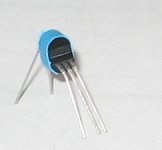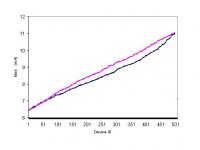EUVL said:> I can help with the North America distribution of your couplers. I'd be interested in 25 myself.
Thanks for the kind offer.
We need two more volunteers and still 375 heatsinks to be accounted for (assuming each person take 25 minimum).
Patrick
I just noticed the 25 minimum. I'll change my 10 to 25.
Thanks
Jim
GB thread started. Pls check to make sure the stated quantities, etc. are correct :
http://www.diyaudio.com/forums/showthread.php?s=&threadid=135359
Merry Christmas,
Patrick
http://www.diyaudio.com/forums/showthread.php?s=&threadid=135359
Merry Christmas,
Patrick
A well used solution, but try to bend the legs so that they will fit the pin layout of the 2SK389s, especially when used as a diff pair.
And compare the surface area that the glue comes into contact with the TO92 casing. The glue is normally the highest resistance. The TO92 molding compound is the next. Aluminium is easily a factor of 10 to 100 better than any polymer, even when filled.
Now only 50 to go.
😉
Patrick
And compare the surface area that the glue comes into contact with the TO92 casing. The glue is normally the highest resistance. The TO92 molding compound is the next. Aluminium is easily a factor of 10 to 100 better than any polymer, even when filled.
Now only 50 to go.
😉
Patrick
EUVL said:A well used solution, but try to bend the legs so that they will fit the pin layout of the 2SK389s, especially when used as a diff pair.
True for 389, but this approach is very convenient for 170 or 74 diff. pair (and BJT diff.), which is what I was thinking of. Should have pointed that out.
EUVL said:And compare the surface area that the glue comes into contact with the TO92 casing. The glue is normally the highest resistance. The TO92 molding compound is the next. Aluminium is easily a factor of 10 to 100 better than any polymer, even when filled.
The glue is very thin, so the conduction is still very good. And for even thinner joint, the parts can be lapped flat with a little very fine wet and dry sandpaper.
Yes, aluminum is a better thermal conductor than glue, but you still have to transfer the heat to the aluminum, either with glue, with thermal grease, or some other bonding agent. And you have two barriers between the parts in your design (part-aluminum-part). Also the fit cannot be as good as two flat surfaces. Thicker interface, combined with larger surface area, is likely a wash.
However, if you want some extra cooling, the finned aluminum piece will provide that, the coupled pair will reduce it, compared to two separate parts.
Didn't intend to imply that it's not a clever solution for where it's needed.
Sheldon
A typical thermal adhesive is an adhesive (e.g. epoxy) with about 60% filler content by volume. For expensive ones, the filler is usually silver or ceramic particules. Average size is 25 to 50 um. At our company where we live on such thermally glued joints, experiments showed that the optimal glue gap is about 0.1mm. Thinner than than, the glue does not adhere. The thicker the glue the higher the thermal resistance.
To minimise the effect of the glue, the simplest way is to increase contact area. In that respect, 0.1mm glue has about the same resistance as about 10mm of aluminium. So the resistance of the aluminium will disappear. True that in the heatsink, you now has 2 glue joints (part-al-part), but the reference is really the aluminium to which both parts are "grounded" to. So we can argue whether it is one or two joints in the chain. In any case, the increase of area due to contact around the cylindrical surface is 2x more than the flat surface alone.
As said in the first post, it is supposed to be directly pin and spacing compatible with 2SK389 / 2SJ109. If you don't need that, ther are many solutions otherwise.
Patrick
To minimise the effect of the glue, the simplest way is to increase contact area. In that respect, 0.1mm glue has about the same resistance as about 10mm of aluminium. So the resistance of the aluminium will disappear. True that in the heatsink, you now has 2 glue joints (part-al-part), but the reference is really the aluminium to which both parts are "grounded" to. So we can argue whether it is one or two joints in the chain. In any case, the increase of area due to contact around the cylindrical surface is 2x more than the flat surface alone.
As said in the first post, it is supposed to be directly pin and spacing compatible with 2SK389 / 2SJ109. If you don't need that, ther are many solutions otherwise.
Patrick
All 500 accpunted for.
Any later comers can have some from my own 100.
Housing : I took you off the list as I have not heard from you. Pls get in touch if you still want some.
Happy New Year,
Patrick
Any later comers can have some from my own 100.
Housing : I took you off the list as I have not heard from you. Pls get in touch if you still want some.
Happy New Year,
Patrick
As mentioned earlier, we have recently measured 500 pcs each of Toshiba (not LS) 2SK170BLs and 2SJ74BLs :
http://www.diyaudio.com/forums/showthread.php?postid=1722442#post1722442
The measurement method has already been described there (single point Idss, 9V Vds, room temperature, steady state). Measurement time is about 1.5 minutes per FET, inclusing calibration time every 10 FETs.
Here are some statistical results.
As you can see from the graph, it is more a linear rather than Gaussian distribution.
This unfortunately means that the quality of match only improves proportionally to pool size (or luck).
From the 500, we obtained :
2SK170BLs
83 pairs matched to < 30uA (including measurement uncertainty)
29 triples matched to < 30uA
15 quads matched to < 30uA
2SJ74BLs
93 pairs matched to < 30uA
31 triples matched to < 30uA
17 quads matched to < 30uA
And 12 complementary quads (2 Ns, 2Ps, same type match < 30uA, N-P match < 60uA)
Less than 10 FETs of the same type cannot find a match to better than 60uA Idss (< 1% match).
I guess a pool size of 1000 might yield slightly better results.
Patrick
http://www.diyaudio.com/forums/showthread.php?postid=1722442#post1722442
The measurement method has already been described there (single point Idss, 9V Vds, room temperature, steady state). Measurement time is about 1.5 minutes per FET, inclusing calibration time every 10 FETs.
Here are some statistical results.
As you can see from the graph, it is more a linear rather than Gaussian distribution.
This unfortunately means that the quality of match only improves proportionally to pool size (or luck).
From the 500, we obtained :
2SK170BLs
83 pairs matched to < 30uA (including measurement uncertainty)
29 triples matched to < 30uA
15 quads matched to < 30uA
2SJ74BLs
93 pairs matched to < 30uA
31 triples matched to < 30uA
17 quads matched to < 30uA
And 12 complementary quads (2 Ns, 2Ps, same type match < 30uA, N-P match < 60uA)
Less than 10 FETs of the same type cannot find a match to better than 60uA Idss (< 1% match).
I guess a pool size of 1000 might yield slightly better results.
Patrick
Attachments
While you're measurements are impressive and not short of state of the art, I would be very much interested in what level of matching is important to reduce distortion significantly.
This seems to be never discussed, at least I could not find any threads here.
Did you maybe look into this? Or have any experiences?
Have fun, Hannes
This seems to be never discussed, at least I could not find any threads here.
Did you maybe look into this? Or have any experiences?
Have fun, Hannes
> I would be very much interested in what level of matching is important to reduce distortion significantly.
That depends on the circuit, doesn't it ?
Patrick
That depends on the circuit, doesn't it ?
Patrick
Sure.
Given that Borbely matches to 0.5mA and Pass/Colburn didn't use matched K170 in the pearl (1mA difference between individual jfets! And that is with degeneration!) I would be curious about real numbers.
Of course everybody goes for tightest matching and may it just so because one can, but so far I haven't seen any numbers - not even simulated ones.
Interestingly it seems nobody was so far interested in that. Maybe just due to the fact that nearly nobody has access to distortion analyzers - Audio Precision for the masses 😀
Have fun, Hannes
Given that Borbely matches to 0.5mA and Pass/Colburn didn't use matched K170 in the pearl (1mA difference between individual jfets! And that is with degeneration!) I would be curious about real numbers.
Of course everybody goes for tightest matching and may it just so because one can, but so far I haven't seen any numbers - not even simulated ones.
Interestingly it seems nobody was so far interested in that. Maybe just due to the fact that nearly nobody has access to distortion analyzers - Audio Precision for the masses 😀
Have fun, Hannes
Thank you Patrick.
I now know, if my math is correct, that 100 would give 25 pairs, but the 30 I recently bought will probably only give me 1 pair. Next time I'll either buy more for matching or even more likely spend the money on prematched devices.
Jim
I now know, if my math is correct, that 100 would give 25 pairs, but the 30 I recently bought will probably only give me 1 pair. Next time I'll either buy more for matching or even more likely spend the money on prematched devices.
Jim
> I now know, if my math is correct, that 100 would give 25 pairs,
100 will probably give you 25 - 30 pairs if you are not trying to match to +/-5uA. I said 30uA because I allow for +/-10uA measurement uncertainty. On the calibrated ammeter with 1uA resolution, they were actually matched to +/-5uA. Below 5uA, it is just too sensitive to temperature fluctuation that the absolute steady state value is more a guess.
> but the 30 I recently bought will probably only give me 1 pair.
Maybe you have better luck than that. It is afterall a random event.
> Next time I'll either buy more for matching or even more likely spend the money on prematched devices.
You may consider PM me for any needs, like another GB member already did.
😉
Patrick
100 will probably give you 25 - 30 pairs if you are not trying to match to +/-5uA. I said 30uA because I allow for +/-10uA measurement uncertainty. On the calibrated ammeter with 1uA resolution, they were actually matched to +/-5uA. Below 5uA, it is just too sensitive to temperature fluctuation that the absolute steady state value is more a guess.
> but the 30 I recently bought will probably only give me 1 pair.
Maybe you have better luck than that. It is afterall a random event.
> Next time I'll either buy more for matching or even more likely spend the money on prematched devices.
You may consider PM me for any needs, like another GB member already did.
😉
Patrick
Hi all,
as promised I had a short look on jfet matching and its relation on distortion, you find the fun here:
http://www.diyaudio.com/forums/showthread.php?s=&threadid=138852
Have fun, Hannes
as promised I had a short look on jfet matching and its relation on distortion, you find the fun here:
http://www.diyaudio.com/forums/showthread.php?s=&threadid=138852
Have fun, Hannes
- Home
- Amplifiers
- Solid State
- The next best thing to 2SK389 / 2SJ109 ?

